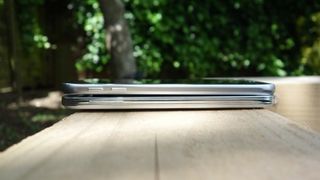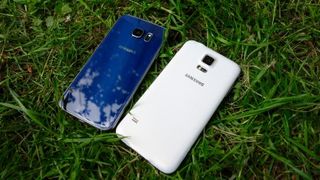As we've touched upon, the Samsung Galaxy S6 and Galaxy S5 are styled quite differently.
Not that you'd say that if you only saw the two phones together head-on. The S6 has the same basic shape, the same lozenge-like physical home key, and the same speaker and logo placement.
The proportions are similar too, with the Galaxy S6 a millimetre or two wider than the Samsung Galaxy S5, but also a similar amount thinner and narrower.
From every angle other than the front, the difference is pronounced. While the removable back cover of the Galaxy S5 is made of cheap-looking dimpled plastic, with a grippy synthetic leather feel, the Galaxy S6 is covered by glass, which tapers off pleasingly at the edges. There's a beguiling glimmering effect to this that sees the true colour of whatever's underneath this glass revealing itself only from an angle.

Of course, the Galaxy S5's plastic rear serves to make the S5 more resistant to day-to-day wear than we fear the Galaxy S6 will be. The Galaxy S6 might have a Gorilla Glass 4 back panel, but it's still glass, and thus will inevitably shatter with a hefty enough drop.
When it comes to the sides, the Samsung Galaxy S6 steps up to a premium matte aluminium. It's easy to say that this is a rip off of the iPhone – and the placement of those drilled speaker holes on the bottom of the phone is certainly reminiscent – but in the flesh it simply doesn't feel that way.
Perhaps it's the subtle lip that Samsung has given this edge, or the way it flattens out along the sides where the volume and power buttons are found.
Get daily insight, inspiration and deals in your inbox
Get the hottest deals available in your inbox plus news, reviews, opinion, analysis and more from the TechRadar team.
Whether you think it's derivative or not, it's a massive improvement over the Galaxy S5's edges, which are made of a kind of shiny plastic that makes a weak attempt to look like metal. While the Galaxy S5 is a more robust phone overall, our seasoned test model bears the kind of collision-scars that make it look like it's been chewed by a dog.

The basic lesson here is that, when it comes to smartphone edges, go metal or go "unapologetically plastic," to borrow from the Jony Ive lexicon.
All of this combines to make the Galaxy S6 feel markedly nicer in the hand. It's actually seven grams lighter than the Samsung Galaxy S5, but it has a denseness and a heft that its predecessor lacks.
Its cold metal edges and cool glass back make it feel every inch the premium bit of kit, whereas the Galaxy S5 feels just the same as any low-end or medium-range handset.
However, for long term calls or media sessions, holding the Galaxy S5 is arguably more comfortable. Its grippy rear and thicker body means that it may not sit nicer in the hand, but it certainly sits better.

While you'll happily throw the Galaxy S5 down onto any surface, it's often a precarious thing to do so with the S6. Its smooth glass back creates a similar effect to the Sony Xperia Z3 Compact and the iPhone 4S, in that it will slide along most soft material surfaces with the slightest incline.
I experienced a number of bizarre self-propelled droppages off my seemingly flat couch arm, though fortunately the drop was always brief and onto soft carpet.
So while these two phones allegedly belong to the same family, their designs suggest that they're suited to different types of people. The Galaxy S5 is a no-nonsense phone that's grippy and rugged. It's built to be lugged around and used heavily, to survive in the real world without a case.
The Galaxy S6, on the other hand, has the combined feel of a piece of jewellery and a high-end camera. You want to handle it carefully, to keep it in a pocket all on its own, to clean its fingerprint-magnet surfaces, and even to invest in a case for it. It's for those who value classy design over practicality, and it's probably not for those who have particularly active jobs or hobbies.
Display
Samsung has long been the master of AMOLED technology on mobile, and both of these phones showcase that expertise.
Both are the same 5.1-inch size, too, which nowadays is a nice balanced size for all-round usage. Though perhaps not quite suitable for comfortable one-handed operation for most people – you'll be wanting a 4.6 or 4.7-inch device like the iPhone 6S or Sony Xperia Z3 Compact for that – they're far from unwieldy. They're not phablets.
The biggest difference between these two displays on paper is resolution. The Galaxy S5 has a 1080p (1920 x 1080) screen, which was par for the course in a flagship Android phone release in mid-2014 (the LG G3 being an exception).
It's still a strikingly vibrant display today, with colours (particularly reds) that pop out of the screen. We also admire how Samsung lets you tone these colours down with a range of display settings.

Overall, the accuracy of the colours here is much better than rival AMOLED efforts like, say, the Moto X 2014.
The Samsung Galaxy S6 display is something else, though. It's a QHD display, which means a resolution of 2560 x 1440. That provides a pixel density of 577ppi versus the Galaxy S5's 432ppi.
To be perfectly honest, though, the difference in sharpness isn't readily apparent for most tasks. Not unless you get right up close, which is kind of silly. It's arguable that you need a 5.5-inch or even a 6-inch display to really start making the most of all those extra pixels.
Watch well-shot 2K or 4K videos on the two and you'll probably pick up the difference, but that's hardly a common occurrence. Not yet, anyway. Don't let that make you think that the Galaxy S6 display isn't a notable step forward, though.
Samsung has improved the quality of its display in general terms, particularly by making it brighter. It's this that makes it look better than the Samsung Galaxy S5 when placed side-by-side rather than the difference in resolution.
If you're looking for a real head turner then the display on the Galaxy S6 Edge is worth checking out. It's curved at either edge resulting in a stunning design. Or you could even opt for the similarly curved and utterly massive Samsung Galaxy S6 Edge+ - although there's a price to pay.
Current page: Design and display
Prev Page Introduction and key features Next Page Interface, performance and batteryMost Popular


